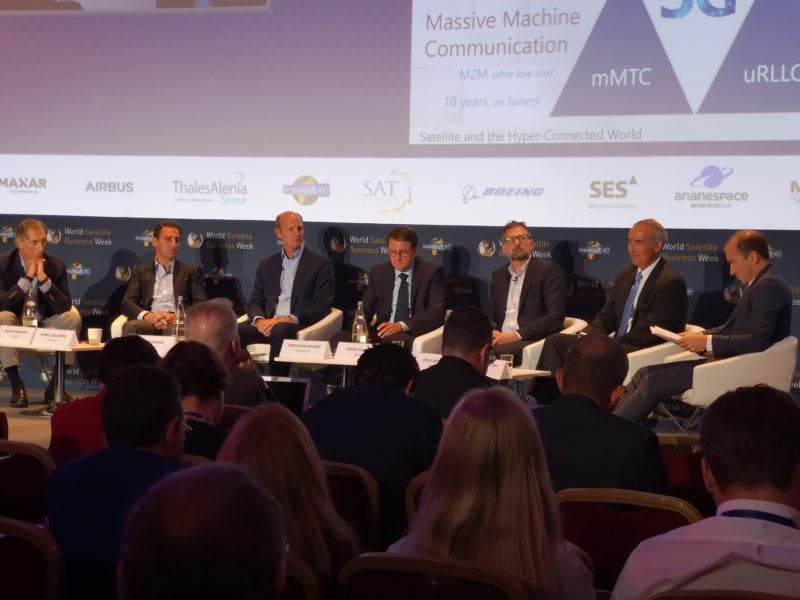Latest News

Panel at World Satellite Business Week (WSBW) 2018 in Paris, France. Photo: Mark Holmes
Chief Executive Officers (CEOs) of the top satellite operators remain optimistic that they can take advantage of new growth opportunities in areas such as In-Flight Connectivity (IFC), 5G, and connected transportation. This was one of the main takeaways of the “Satellite and the Hyper-Connected World: The view from leading operators and businesses” panel at World Satellite Business Week (WSBW) in Paris.
With many now at an inflection point of their strategies to grow outside of video, it promises to be an interesting time for all the players involved. SES CEO Steve Collar pointed out the transformation that is now taking place in the SES business. “On the networks side, we are seeing some really fast growth. In four years, it will be 50/50 in terms of video and networks for SES. Our main focus is making sure we are delivering to our customers and driving revenue through our new satellites. We are super excited about the long-term future we are building. We have a good position in Non-Geostationary Satellite Orbit (NGSO),” he said.
Eutelsat CEO Rodolphe Belmer was also keen to point out how Eutelsat will now look to grow through its broadband initiatives. He said Eutelsat’s return to growth strategy is based around broadband. “We believe bringing broadband where telcos cannot go is the core of our industry. We have procured a Very High Throughput Satellite (VHTS) from Thales Alenia Space which will come into service in 2021. We can benefit from a satellite that delivers a service like fiber.”
While Eutelsat is making steps with its broadband strategy, it is working hard to make sure it does not miss a beat in terms of video. Belmer, who has a strong video background himself, is optimistic that the operator can deliver consistent video growth. “The number of channels are growing 5 percent year-on-year,” he said. “There is more High Definition (HD) in every geography. Satellite TV penetration is growing around the world. As a result, our pricing power is increasing. We want to bring the benefits of Over-the-Top (OTT) to satellite. What people want is to be able to stream services like Netflix, YouTube, and Facebook.”
For Inmarsat, which has a different focus than other operators, connected transportation and in particular, IFC, will be key to its success going forward. Inmarsat CEO Rupert Pearce told the event the big market for Inmarsat was IFC. Inmarsat now has 1,600 aircraft in its backlog waiting to be connected. “Airlines are taking their time to make decisions in IFC. I don’t think that will change. Airlines have discovered that a terrible IFC system is worse than no IFC system,” he said. Pearce said airlines are beginning to realise that a connected passenger is incredibly valuable. “The London School of Economics said in a recent study that the connected passenger market will be worth $130 billion. It is a transformational economic option for airlines,” he added.
Telesat CEO Dan Goldberg also echoed Pearce’s sentiments on the IFC market. “We think IFC is a very interesting market. They need tonnes of capacity. They want gate-to-gate capacity, One of the reason we embraced Low Earth Orbit (LEO) is when we take a step back, I don’t know any other way to solve it (capacity needs) than bring a constellation that can check all of the boxes,” he said.
For Telesat, a lot of the discussion centered around its ambitious plans in LEO where it plans to launch hundreds of satellites going forward. Goldberg said Telesat had seen a lot of interest throughout the commercial and government markets for LEO solutions. He admitted what Telesat was doing in LEO is “technically ambitious.” “Most people in the developing world get on the internet via their mobile devices. These telcos don’t like buying satellite and then integrating it in their network. Satellite capacity needs to be Metro Ethernet Forum (MEF) compatible, for example. The demand is absolutely there. This is the future for satellite.”
Clash
While the panel was largely conducted in good spirits, the main clash came around 5G and the relationships between satellite players and telcos going forward, which provoked a little controversy. While Intelsat has pioneered some interesting spectrum sharing initiatives in the US, it seemed clear that Viasat CEO Mark Dankberg had a very different view than Intelsat’s. “I don’t see the mobile operators as our friends. We need to be extremely wary of how we throw ourselves on the 5G bandwagon. Spectrum is hugely important for us,” he said.
Intelsat CEO Stephen Spengler took an opposite view, believing what Intelsat was doing could be key for the satellite industry to play a fuller role on the 5G landscape going forward. “5G is a huge gamechanger for us. We see satellite as part of the standards discussion now. Standards around 5G have huge potential for our sector. There will be multi-faceted ways to play in 5G. Satellite has unique attributes. We have a lot of work to do to embrace this (5G),” he added.
Get the latest Via Satellite news!
Subscribe Now